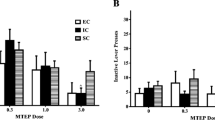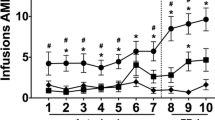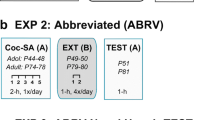Abstract
Rats with different behavioral histories, defined by rearing and housing in either an enriched condition (EC) or an isolation condition (IC), were trained in a two-lever operant procedure to discriminate 5.0 mg/kg cocaine from saline. In cocaine dose-generalization tests, the IC rats exhibited an ED50 (1.01 mg/kg) significantly lower than the EC rats (ED50:1.55 mg/kg). The cocaine-appropriate responding was emitted when the rats were treated withd-amphetamine, and for thed-amphetamine test doses the ED50 (0.19 mg/kg) was again significantly lower for the IC rats compared to the ECs (ED50:0.33 mg/kg). These data suggest that IC rats are more sensitive to the stimulus properties of indirect dopaminergic agonists than EC rats and highlight the importance of environmental variables in governing an organism's response to the stimulus properties of abused drugs.
Similar content being viewed by others
References
Bennett EL, Rosenzweig (1981) Behavioral and biochemical methods to study brain responses to environment and experience. In: Lahue L (ed) Methods in neurobiology, vol 2. Plenum Press, New York, pp 101–141
Black JE, Issacs KR, Anderson BJ, Alcantara AA, Greenough WT (1990) Learning causes synaptogenesis, whereas motor activity causes angiogenesis, in the cerebellar cortex of rats. Proc Natl Acad Sci USA 87:5568–5572
Boyle AE, Gill K, Smith BR, Amit Z (1991) Differential effects of an early housing manipulation on cocaine-induced activity and self-administration in laboratory rats. Pharmacol Biochem Behav 39:269–274
Brocco MJ (1980) The isolation syndrome in rhesus monkeys: behavioral, pharmacological, and electrophysiological analyses. Diss Abstr Int 41[12-B]:4484
Colpaert FC (1987) Drug discrimination: Methods of manipulation, measurement, and analysis. In: Bozarth MA (ed) Methods of assessing the reinforcing properties of abused drugs. Springer, Berlin Heidelberg New York, pp 341–372
Creese I, Burt DA, Snyder SH (1977) Dopamine receptor binding enhancement accompanies lesion-induced behavioral supersensitivity. Science 197:596–598
Fowler SC (1987) Force and duration of operant response as dependent variables in behavioral pharmacology. In: Thompson T, Dews PB, Barrett JE (eds) Neurobehavioral pharmacology, advances in behavioral pharmacology, vol 6. Erlbaum, Hillsdale, NJ, pp 83–127
Greenough WT (1975) Experiential modification of the developing brain. Am Scientist 63:37–46
Johanson CE, Fischman MW (1989) The pharmacology of cocaine related to its abuse. Pharmacol Rev 41:3–52
Kaempf GL, Kallman MJ (1987) A comparison of testing procedures on the discriminative morphine cue. Psychopharmacology 91:56–60
Overton DA (1987) Applications and limitations of the drug discrimination method for the study of drug abuse. In: Bozarth MA (ed) Methods of assessing the reinforcing properties of abused drugs. Springer, Berlin Heidelberg New York, pp 291–340
Renner MJ, Rosenzweig MR (1987) Enriched and improverished environments: effects on brain and behavior. Springer, Berlin Heidelberg New York
Sahakian BJ, Robbins TW (1977) Isolation-rearing enhances tail pinch-induced oral behavior in rats. Physiol Behav 18:53–58
Sahakian BJ, Robbins TW, Morgan MJ, Iversen SD (1975) The effects of psychomotor stimulants on stereotypy and locomotor activity in socially-deprived and control rats. Brain Res 84:195–205
Schenk S, Lacelle G, Gorman K, Amit Z (1987) Cocaine self-administration in rats influenced by environmental conditions: implications for the etiology of drug abuse. Neurosci Lett 81:227–231
Simon P, Sultan Z, Chermat R, Boissier JR (1972) Cocaine, an amphetamine-like drug? A problem of experimental psychopharmacology. J Pharmacol (Paris) 3:129–142
Stolk JM, Rech RH (1968) Species differences in amphetamine toxicity: effects of aggregation, acute and chronic reserpine treatment in mice and rats. Life Sci 7:1299–1309
Author information
Authors and Affiliations
Additional information
Supported by DA 05310.
Rights and permissions
About this article
Cite this article
Fowler, S.C., Johnson, J.S., Kallman, M.J. et al. In a drug discrimination procedure isolation-reared rats generalize to lower doses of cocaine and amphetamine than rats reared in an enriched environment. Psychopharmacology 110, 115–118 (1993). https://doi.org/10.1007/BF02246959
Received:
Revised:
Issue Date:
DOI: https://doi.org/10.1007/BF02246959




